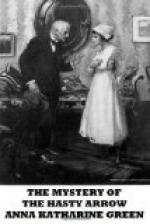To those who knew William Jewett well, it was evident that he had been called from some task which still occupied his thoughts and for the moment somewhat bewildered his understanding. But as he was a conscientious man and quite capable of taking the lead when once roused to the exigencies of an occasion, Mr. Roberts felt a certain interest in watching the slow awakening of this self-absorbed man to the awful circumstances which in one instant had clouded the museum in an atmosphere of mysterious horror.
When the full realization came,—which was not till a way had been made for him to the side of the stricken woman crouching over the dead child,—the energy which transformed his countenance and gave character to his usually bent and inconspicuous figure was all if not more than the anxious director expected.
Finding that his attempts to meet the older woman’s eye only prolonged the suspense, the Curator addressed her quietly, and in sympathetic tones inquired whose child this was and how so dreadful a thing had happened.
She did not answer. She did not even look his way. With a rapid glance into the faces about him, ending in one of deep compassion directed toward herself, he repeated his question.
Still no response—still that heavy silence, that absolute immobility of face and limb. If her faculty of hearing was dulled, possibly she would yield to that of touch. Stooping, he laid his hand on her arm.
This roused her. Slowly her eyes lost their fixed stare and took on a more human light. A shudder shook her frame, and gazing down into the countenance of the young girl lying at her feet, she broke into moans of such fathomless despair as wrung the hearts of all about her.
It was a scene to test the nerve of any man. To one of the Curator’s sympathetic temperament it was well-nigh unendurable. Turning to those nearest, he begged for an explanation of what they saw before them:
“Some one here must be able to tell me. Let that some one speak.”
At this the quietest and least conspicuous person present, a young man heavily spectacled and of student-like appearance, advanced a step and said:
“I was the first person to come in here after this poor young lady fell. I was looking at coins just beyond the partition there, when I heard a gasping cry. I had not heard her fall—I fear I was very much preoccupied in my search for an especial coin I had been told I should find here—but I did hear the cry she gave, and startled by the sound, left the section where I was and entered this one, only to see just what you are seeing now.”
The Curator pointed at the two women.
“This? The one woman kneeling over the other with her hand on the arrow?”
“Yes, sir.”
A change took place in the Curator’s expression. Involuntarily his eyes rose to the walls hung closely with Indian relics, among which was a quiver in which all could see arrows similar to the one now in the breast of the young girl lying dead before them.




